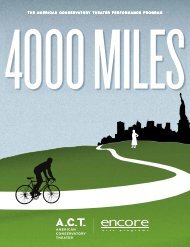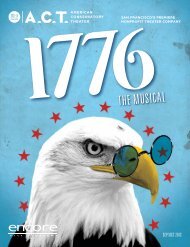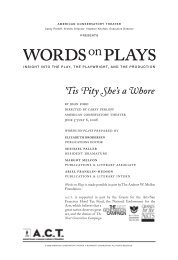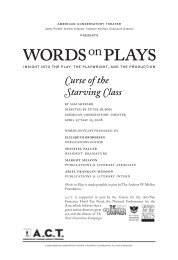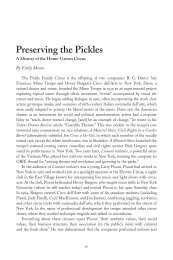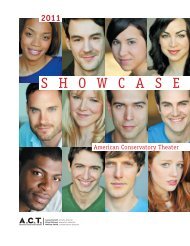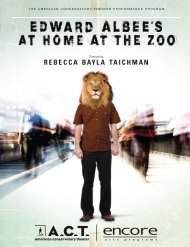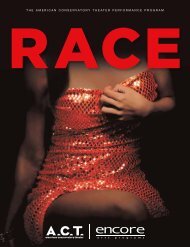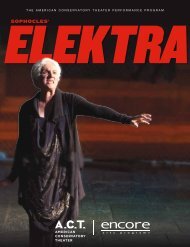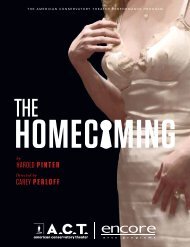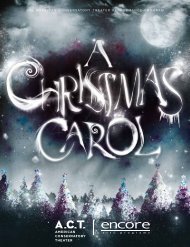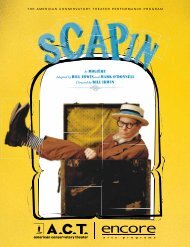WHO'S WHO - American Conservatory Theater
WHO'S WHO - American Conservatory Theater
WHO'S WHO - American Conservatory Theater
Create successful ePaper yourself
Turn your PDF publications into a flip-book with our unique Google optimized e-Paper software.
THE GALLERY<br />
AT A.C.T.<br />
Find yourself<br />
with some<br />
extra time before<br />
a performance or<br />
during intermission?<br />
Want to expose<br />
yourself to more fi ne<br />
art, but don’t make<br />
it to art galleries as<br />
often as you’d like?<br />
PHOZELLE 2<br />
Now you need look<br />
no further than<br />
A.C.T. We invite you to visit the second fl oor of the theater<br />
(just outside the auditorium doors, along the north bank of<br />
windows, and by the elevator) to view original artwork by<br />
a diverse range of artists, presented in a series of rotating<br />
exhibits throughout the 2007–08 season.<br />
paintings by deborah barlow<br />
Formerly of the Bay Area, Barlow is now a Boston-based<br />
artist who has been featured in several previous gallery<br />
shows at A.C.T. She describes her work as closely aligned<br />
with nature. “What compels me most is the natural world<br />
at the edges. The extremes are most provocative to me—the<br />
emptiness of a desert expanse or the intricate layering of a<br />
microscopic world view. It’s what isn’t obvious that keeps me<br />
looking, and I look without any desire to mimic or reproduce<br />
those marginal worlds. My paintings are not objects as much<br />
as they are a record of how to search.”<br />
Barlow exhibits her work in galleries in the United States,<br />
Canada, and Europe. She represented the United States in<br />
the International Biennial of Contemporary Art in Florence,<br />
Italy, and was artist-in-residence at Anam Cara in County<br />
Cork Ireland. In summer 2007 she was featured at the<br />
Chautauqua Institution in New York. She will be exhibiting<br />
at the Lyman-Eyer Gallery in Provincetown, Massachusetts,<br />
in July 2008.<br />
Each artwork purchase benefi ts A.C.T. For more<br />
information about Deborah Barlow, please contact Kevin<br />
Simmers at 415.474.1066 / krscreativeoptns@aol.com.<br />
OZONE-BLUE O<br />
SHIVER<br />
CONTINUED<br />
C<br />
He left untouched the social institutions. He<br />
neglected the questions of serfdom and the<br />
autocratic state, ludicrously claiming that both<br />
were perfectly acceptable so long as they were<br />
combined with Christian principles.<br />
The very institutions that Gogol ridiculed in The Government<br />
Inspector he now claimed to be of divine origin. “God,” he wrote,<br />
“had invisibly guided the hand of the czars.”<br />
All this, however, was Gogol’s reinterpretation of the play as<br />
he became consumed with religious fervor. In his plea to Pushkin<br />
for a little inspiration, after all, Gogol said that he was itching<br />
to write a comedy—and this is exactly what he did. It is, for<br />
all of his later protestations, a comedy about greedy politicians<br />
scurrying for cover when they fear they’ve been caught out,<br />
about the pretensions of the crude, brutal, and heavy handed to<br />
cultivation, civility, and sophistication. It’s about the triumph of a<br />
wild, childlike imagination over cold, calculating cynicism—even<br />
as the owner of that imagination is never entirely aware of the<br />
chaos he creates in his wake.<br />
It is also a comedy that, despite its reputation as a work of<br />
realistic satire, is perhaps the theater’s greatest example of lunatic<br />
surrealism. In the world of this play, the fact that the court clerk’s<br />
nanny once dropped him on his head is reason enough for his<br />
smelling of vodka for the rest of his life. It’s a play in which a<br />
harmless nincompoop is taken as a powerful government offi cial on<br />
no real evidence whatsoever. But then, Gogol was the author who<br />
peopled his Ukrainian Tales with demons, ghosts, and powerful<br />
wizards and who wrote a story in which a nose leaps off its own<br />
face and dashes about St. Petersburg in a uniform and carriage.<br />
In his book on Gogol, Vladimir Nabokov captures better than<br />
anyone the specifi c world of The Government Inspector:<br />
The play begins with a blinding flash of<br />
lightning and ends in a thunderclap. In fact<br />
it is wholly placed in the tense gap between<br />
the fl ash and the crash. There is no so-called<br />
“exposition.” Thunderbolts do not lose time<br />
explaining meteorological conditions. The whole<br />
world is one ozone-blue shiver and we are in the<br />
middle of it.<br />
It’s a very funny place to be. ■<br />
The Government Inspector 29



